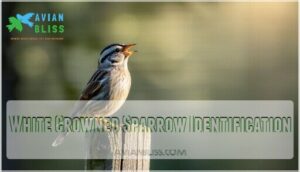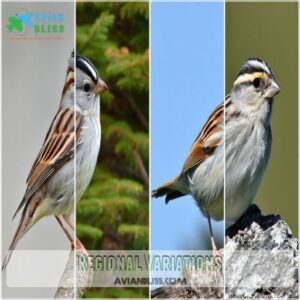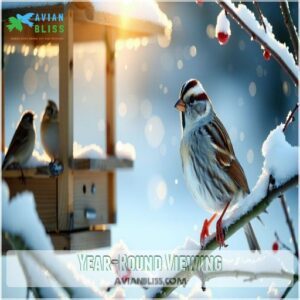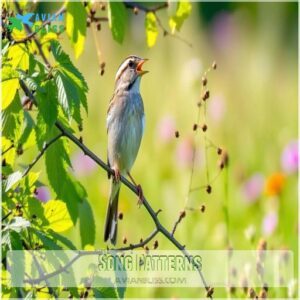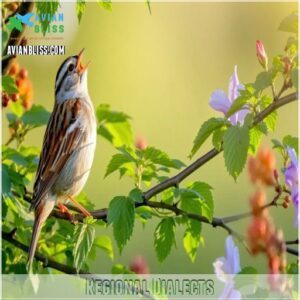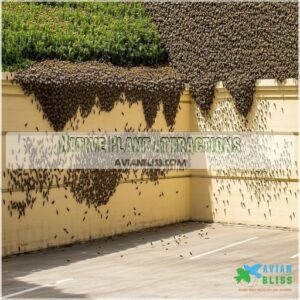This site is supported by our readers. We may earn a commission, at no cost to you, if you purchase through links.
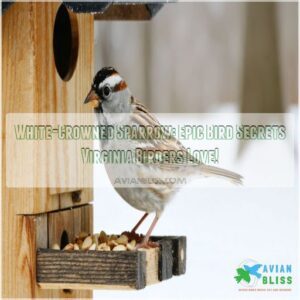
In Virginia, you’ll find them flocking to backyard feeders in winter, enjoying sunflower seeds and millet. Their regional head stripe colors add a touch of flair, while juveniles sport earthy brown stripes before maturing into striking contrast.
Watch for their unique “two-step” foraging dance as they scratch and hop for food. Curious about their favorite seeds or habitats? Stick around!
Table Of Contents
- Key Takeaways
- White Crowned Sparrow Identification
- Habitat and Distribution
- Sparrow Behavior and Diet
- Attracting White Crowned Sparrows
- Sparrow Comparison and Rarity
- Frequently Asked Questions (FAQs)
- What does a White-crowned Sparrow look like?
- Are white crowned sparrows avian royalty?
- Are white crowned sparrows a winter bird?
- When do white crowned sparrows come out?
- Do white crowned sparrows sing?
- How rare is a White-crowned Sparrow?
- What does it mean when you see a White-crowned Sparrow?
- What is the difference between a field sparrow and a White-crowned Sparrow?
- Are White-crowned Sparrows aggressive?
- Where do White-crowned Sparrows live?
- Conclusion
Key Takeaways
- You’ll recognize White-crowned Sparrows by their bold black-and-white head stripes, gray breast, and orange bill, making them easy to spot in your yard during winter.
- They love sunflower seeds, millet, and cracked corn, so offering these at your feeders can attract them to your backyard.
- These sparrows are migratory, traveling from tundra summer homes to wintering spots across the U.S., including Virginia from September to April.
- Their songs and regional dialects are unique, with males singing sweet whistling melodies that vary by location.
White Crowned Sparrow Identification
The White-crowned Sparrow captivates with its distinctive black-and-white head stripes and crisp gray breast.
Look closely, and you’ll notice their smart, dashing appearance with an orange bill that sets them apart from other sparrows in the Virginia landscape.
Physical Characteristics
Ever wondered what makes White-crowned Sparrows stand out in Virginia’s birding scene? These small songbirds pack a punch with their distinctive physical characteristics.
Here’s what sets them apart: Their stout build and precise dimensions make them true avian marvels of the backyard bird world.
- Compact size: 5.9-6.3 inches long
- Lightweight champions: Just 0.9-1.0 ounces
- Impressive wingspan: 8.3-9.4 inches
- Perfectly proportioned body structure
Color Patterns
Scan a White-crowned Sparrow’s plumage, and you’ll spot nature’s artistry. Crisp black and gray feathers contrast beautifully, making these sparrows a visual delight for Virginia birders.
Juvenile birds rock nutmeg brown head stripes that transform into striking black-and-white patterns come spring. Their head stripe color and lores vary by region, creating a unique color palette.
The white throated sparrow species also exhibits distinctive markings that aid in identification.
Bill Size and Shape
Like a Swiss Army knife of the bird world, the White-crowned Sparrow’s bill is a marvel of dietary adaptations. Its stout, conical shape reveals fascinating bill morphology that speaks volumes about evolutionary pressures.
- Precision-crafted for seed cracking
- Compact yet powerful design
- Perfectly suited for varied foraging
These bills vary subtly, sporting colors from yellow to pink, showcasing nature’s ingenious survival toolkit for these feathered friends.
Regional Variations
White-crowned Sparrows showcase fascinating regional plumage variations across North America, with a bill shape that hints at their genetic story.
From the Pacific Coast to the Rockies and Alaska, each subspecies displays unique lores color and head stripe patterns.
Imagine these birds as nature’s regional ambassadors, their geographic distribution painting a living map of adaptation and diversity.
Habitat and Distribution
White-crowned Sparrows are masters of adaptability, switching between tundra landscapes in summer and cozy suburban margins in winter.
These remarkable birds traverse vast distances across North America.
They transform from alpine dwellers to backyard visitors with a seasonal precision that’ll make any Virginia birder’s heart skip a beat.
Summer Habitats
Want to track down the White-crowned Sparrow’s summer hangout? These feathered adventurers transform Canada’s tundra and Alaska’s alpine meadows into their breeding paradise. The Alaska breeding process is essential for the species’ survival.
Boreal forests become their summer playground, where they build nests and raise their young.
Imagine a landscape of wild beauty, where these sparrows hop and chirp, turning harsh wilderness into a vibrant avian home.
Winter Appearances
From September to April, White-crowned Sparrows transform from summer alpine habitat explorers into winter wanderers across Virginia’s landscapes. They flock to backyard feeders, sporting crisp winter plumage.
You’ll spot them hopping around yard edges, devouring sunflower seeds, and showcasing remarkable survival strategies. These strategies make them beloved winter visitors among local birding enthusiasts.
To attract more small birds to your yard, consider offering a variety of seed types and suet cakes. This can help support their winter survival.
Migration Patterns
Some White-crowned Sparrows begin epic migration journeys that’ll make your jaw drop! Their sparrow migration routes reveal incredible avian navigation skills.
Check out these mind-blowing travel details:
- Traverse up to 2,600 miles between breeding and wintering grounds
- Navigate using celestial cues and magnetic field sensing
- Follow precise seasonal movement patterns across North American landscapes
These feathered travelers showcase nature’s most impressive long-distance migration strategies.
Year-Round Viewing
Want to catch a glimpse of white-crowned sparrows throughout the year? The Northwest offers constant observation of resident populations, making extended viewing a birdwatcher’s dream.
These winter birds frequent backyard feeders, providing year-round presence even in cooler months.
Your birdwatching skills can reveal the secret to spotting these charming sparrows in their natural habitat, regardless of the season.
Sparrow Behavior and Diet
If you’re keen to understand the fascinating world of White-crowned Sparrows, watch how they scratch backwards with both feet while foraging in your backyard.
Their diet consists mostly of seeds, but during nesting season, they’ll surprise you by catching insects mid-flight to feed their hungry hatchlings.
Foraging Behavior
White-crowned Sparrows dance across the ground with a unique foraging rhythm that’ll catch any bird watcher’s eye. Their signature move? Scratching backwards with both feet, then hopping forward to snag a meal.
Here’s how they hunt for dinner:
- Backward scratch technique
- Quick forward hop
- Seed selection skills
- Insect tracking precision
- Ground-level food scanning
This clever hunting strategy helps them survive winter’s lean times.
Song Patterns
The white-crowned sparrow’s bird species behavior and songs have been extensively studied to understand their migration patterns and habitat preferences.
Males belt out songbird symphonies lasting 2-3 seconds, their mating calls echoing across territories. These seasonal variations are nature’s poetry, with males singing far more frequently than their quieter female counterparts.
After scratching through seeds, you’ll catch a white-crowned sparrow’s learned melodies – a sweet whistling intro, jumbled notes, and a buzzing finale.
Regional Dialects
Imagine sparrows as musical linguists, each region crafting its unique song signature.
These feathered performers develop distinctive dialect variations through a fascinating learning process, where geographic influences shape their vocal repertoire.
Their cultural transmission of songs creates a melodic map across landscapes, with white-crowned sparrow populations singing their own local tunes like neighborhood dialects.
Seed-Based Diet
White-crowned Sparrows are unique not only for their regional song styles, but also for their seed-based diet, a true survival masterpiece.
In winter, these feathered foodies gobble up cracked corn, sunflower seeds, and millet.
Understanding their seed preferences and year-round dietary needs can transform your backyard into a sparrow restaurant, turning casual bird watching into a front-row feast for these picky eaters.
Attracting White Crowned Sparrows
Want to turn your backyard into a White-crowned Sparrow hotspot?
By setting up the right seeds, native plants, and water sources, you’ll create an irresistible haven that’ll have these charming black-and-white-headed birds hopping and chirping in no time.
Seed Preferences
White-crowned Sparrows typically crave a diverse seed buffet that keeps them coming back to your backyard feeders. These feathered friends have specific seed preferences that can make or break their dining experience.
- Sunflower seeds: The ultimate sparrow crowd-pleaser
- Nyjer seeds: A tiny treasure they can’t resist
- Millet: The reliable staple of their diet
- Cracked corn: A protein-packed winter favorite
- Mixed seed blends: Nature’s perfect sparrow smorgasbord
Native Plant Attractions
Wildflowers and native shrubs are your secret weapon for attracting white-crowned sparrows to your garden.
Plant species like serviceberry, goldenrod, and elderberry create eco-friendly habitats that support these charming birds.
Using native plant seeds is essential for designing a garden that attracts white-crowned sparrows.
By designing a wildlife conservation-focused garden with strategic seed selection, you’ll transform your backyard into a sparrow sanctuary that feels like home.
Water Source Requirements
After planting native shrubs that attract sparrows, you’ll want to seal the deal with the right water source. Think shallow, clean pools that invite white-crowned sparrows to drink and bathe.
Understanding bird conservation efforts is essential for creating an ideal environment.
A dripping faucet or carefully designed birdbath can transform your sparrow habitat, providing the clean water circulation these birds crave for survival and bird conservation.
Backyard Viewing Tips
Want to turn your backyard into a white-crowned sparrow hotspot? Here’s your ultimate bird-watching cheat sheet:
- Strategic feeder placement near shrubs
- Install multiple bird baths with fresh water
- Create diverse yard layout with native plants
- Use wildlife cameras for discreet observation
Understanding the white throat patch characteristics can help you better identify these birds and create a more welcoming environment.
Blend garden design with sparrow-friendly features, and watch these feathered friends make your backyard their favorite hangout spot.
Sparrow Comparison and Rarity
If you’re a Virginia birder, you’ll find White-crowned Sparrows are a rare winter treat, appearing in just 2% of checklists.
They stand out from their sparrow cousins like the Song and Field Sparrows.
You’ll want to keep your binoculars ready to spot these distinctive black-and-white-headed birds hopping along trail edges and yard margins during their seasonal visits.
Comparison to Song Sparrows
While Song Sparrows might seem like cousins to White-crowned Sparrows, they’re quite different birds with unique characteristics.
Check out this quick comparison to master bird identification like a pro:
| Characteristic | White-crowned Sparrow | Song Sparrow |
|---|---|---|
| Size | 5.9-6.3 inches | Slightly smaller |
| Head Pattern | Black and white stripes | Brown streaked |
| Song | Complex regional dialects | More repetitive melody |
| Habitat | Tundra to meadows | More widespread |
Comparison to Field Sparrows
The Field Sparrow and White-crowned Sparrow offer birders a fascinating comparison of similar yet distinct species.
Check out how these feathered friends stack up:
| Characteristic | White-crowned Sparrow | Field Sparrow |
|---|---|---|
| Sparrow Size | 5.9-6.3 in | 5.1-5.9 in |
| Feather Color | Black and white head | Rusty cap, gray face |
| Habitat Overlap | Fields, woodland edges | Grasslands, shrubby areas |
Their unique features make species distinction a thrilling challenge for Virginia bird enthusiasts.
Rarity in Virginia
If Field Sparrows seem common, White-crowned Sparrows play hard to get in Virginia. These rare visitors peek into local landscapes, creating excitement for bird enthusiasts.
Check out how scarce these feathered friends are: Identifying sparrows with yellow on head markings can be challenging, but understanding their characteristics is essential for birders.
| Sighting Category | Frequency | Probability |
|---|---|---|
| Annual Occurrence | Low | 2% |
| Winter Presence | Rare | Minimal |
| Regional Distribution | Scattered | Unpredictable |
| Migration Zones | Limited | Selective |
| Local Abundance | Minimal | Sporadic |
Catching a glimpse feels like winning a birding lottery in the Old Dominion!
Winter Checklist Appearances
Winter sightings of white-crowned sparrows in Virginia bring a sense of wonder during chilly months. Recorded in just 2% of bird checklists, spotting one feels special.
These seasonal trends highlight their movement to wintering grounds. Understanding bird counts is essential for tracking these patterns. Curious about numbers?
| Term | Meaning |
|---|---|
| Bird Counts | Measures winter sparrows seen. |
| Flock Dynamics | How sparrows group together. |
| Seasonal Trends | Patterns in migrations. |
| Cold Weather | Ideal timing for birders. |
| Regional Differences | Variations across states. |
Frequently Asked Questions (FAQs)
What does a White-crowned Sparrow look like?
With a head striped like a tiny referee, White-crowned Sparrows sport crisp black-and-white markings, gray breasts, and orange bills.
Their bold, dashing look is unmistakable, while juveniles wear earthy brown stripes until spring.
Are white crowned sparrows avian royalty?
Not exactly royalty, but White-crowned Sparrows do sport a striking "crown" of black and white stripes like nature’s little monarchs.
Their elegant look and sweet songs definitely make them standout members of the bird world.
Are white crowned sparrows a winter bird?
Think of White-crowned Sparrows as nature’s snowbirds.
They’re not strictly "winter birds," but in the U.S., they brighten winter landscapes from September to April, visiting yards and fields before heading north for summer breeding.
When do white crowned sparrows come out?
White-crowned Sparrows usually show up in late September, hanging around until April in most areas.
During summer, they retreat to northern tundras and alpine meadows, so don’t expect to spot them year-round unless you’re in the Northwest.
Do white crowned sparrows sing?
It’s like nature’s way of showing off.
Males belt out clear, sweet whistles, especially in winter.
These songs even develop regional “dialects,” making their tunes as unique as local accents.
How rare is a White-crowned Sparrow?
Spotting a White-crowned Sparrow isn’t too rare, especially in their migration seasons.
You’ll often see them in fields, yards, or trails.
Their distinctive black-and-white striped heads make them stand out wherever they appear.
What does it mean when you see a White-crowned Sparrow?
Seeing a White-crowned Sparrow, one of winter’s 2% checklist stars in Virginia, often signals seasonal change.
They remind you to embrace shifts, as these hardy travelers bring beauty, adaptability, and nature’s rhythm to your backyard.
What is the difference between a field sparrow and a White-crowned Sparrow?
A Field Sparrow has a pale pink bill, a plain face, and a white eye ring.
A White-crowned Sparrow sports bold black-and-white head stripes and an orange or pale beak.
Are White-crowned Sparrows aggressive?
About 80% of small bird species show territorial behavior, but White-crowned Sparrows aren’t overly aggressive.
They’ll defend their space during breeding or feeding but rarely fight—think firm boundaries rather than full-on bird brawls.
Where do White-crowned Sparrows live?
White-crowned Sparrows live in tundra, alpine meadows, and boreal forests during summer, mainly in Canada and Alaska.
In winter, you’ll find them in fields, roadsides, and low foliage across the United States, especially September-April, where they are often seen in fields.
Conclusion
Picture the crisp Virginia winter air as a White-crowned Sparrow hops into view, its bold black-and-white head stripes a striking contrast against the frost.
These small songbirds reward you with their lively foraging and sweet melodies, brightening even the grayest days.
Attract them with sunflower seeds, millet, and native plants, and watch their graceful “two-step” unfold.
Whether you’re a seasoned birder or a curious newcomer, keeping an eye out for these beauties adds joy to winter birdwatching adventures.

